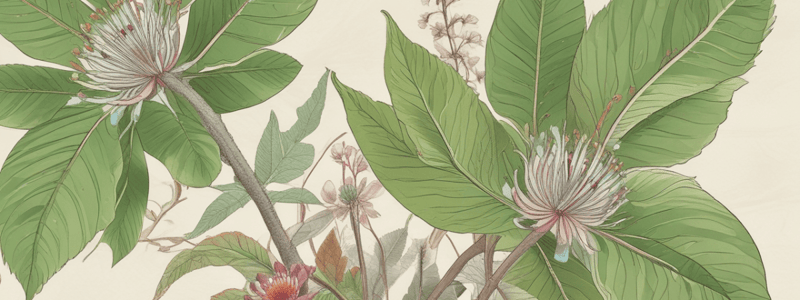Podcast
Questions and Answers
What is the main function of the chloroplasts in plant cells?
What is the main function of the chloroplasts in plant cells?
- Pigment synthesis
- Cell wall formation
- Protein synthesis
- Photosynthesis (correct)
What is the outer layer of the root that regulates water and ion uptake?
What is the outer layer of the root that regulates water and ion uptake?
- Xylem
- Cortex
- Phloem
- Epidermis (correct)
Which plant tissue is responsible for storage, support, and photosynthesis?
Which plant tissue is responsible for storage, support, and photosynthesis?
- Vascular tissue
- Ground tissue (correct)
- Epidermal tissue
- Dermal tissue
What is the main function of the xylem in vascular tissue?
What is the main function of the xylem in vascular tissue?
What is the main function of the cuticle in leaf structure?
What is the main function of the cuticle in leaf structure?
What is the main function of the companion cells in phloem?
What is the main function of the companion cells in phloem?
What is the primary role of chloroplasts in plant cells?
What is the primary role of chloroplasts in plant cells?
Which type of plant is characterized by producing seeds, but not flowers?
Which type of plant is characterized by producing seeds, but not flowers?
What is the process by which plants convert light energy into chemical energy?
What is the process by which plants convert light energy into chemical energy?
What is the term for growth responses to environmental stimuli, such as light and touch?
What is the term for growth responses to environmental stimuli, such as light and touch?
Which plant organ is responsible for absorbing water and nutrients from the soil?
Which plant organ is responsible for absorbing water and nutrients from the soil?
What is the term for the process of transporting water and nutrients from roots to leaves?
What is the term for the process of transporting water and nutrients from roots to leaves?
Flashcards are hidden until you start studying
Study Notes
Plant Anatomy Overview
- The study of the internal structure and organization of plants
- Deals with the shape, size, and arrangement of cells, tissues, and organs
Plant Cells
- Eukaryotic cells with cell walls made of cellulose
- Have plastids (chloroplasts, chromoplasts, leucoplasts) for photosynthesis and pigment synthesis
- Have a large central vacuole for storage and maintenance of cell turgor pressure
Plant Tissues
- Dermal tissue: outer layer of cells, protects plant from water loss and pathogens
- Ground tissue: inner tissue, responsible for storage, support, and photosynthesis
- Vascular tissue: transports water, nutrients, and sugars throughout the plant
Plant Organs
- Roots: absorb water and minerals, anchor plant in soil
- Stems: support plant, transport materials, and store food
- Leaves: site of photosynthesis, regulate water loss
Root Structure
- Root cap: protects root tip during growth
- Epidermis: outer layer, regulates water and ion uptake
- Cortex: inner tissue, stores food and water
- Xylem: transports water and minerals from roots to leaves
- Phloem: transports sugars and organic compounds from leaves to roots
Stem Structure
- Epidermis: outer layer, regulates water loss and protects stem
- Cortex: inner tissue, stores food and water
- Xylem: transports water and minerals from roots to leaves
- Phloem: transports sugars and organic compounds from leaves to roots
Leaf Structure
- Cuticle: outer waxy layer, reduces water loss
- Epidermis: outer layer, regulates gas exchange and water loss
- Mesophyll: inner tissue, site of photosynthesis
- Chloroplasts: organelles responsible for photosynthesis
Vascular Tissue
- Xylem: transports water and minerals from roots to leaves
- Tracheids: dead cells that transport water and minerals
- Vessel elements: dead cells that transport water and minerals
- Phloem: transports sugars and organic compounds from leaves to roots
- Sieve cells: living cells that transport sugars and organic compounds
- Companion cells: living cells that support sieve cells
Studying That Suits You
Use AI to generate personalized quizzes and flashcards to suit your learning preferences.




